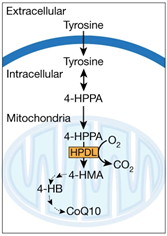Sometimes, while investigating one question, scientists learn the answer to an entirely different one. Some of the most significant medical breakthroughs have begun with open-ended curiosity: insulin, for example, was discovered after two German doctors removed a dog’s pancreas in 1890 to better understand its role in digestion.

Closer to home, while studying the role of oxygen in metabolic processes, Damon Runyon alumni Robert Banh, PhD, and Michael Pacold, MD, PhD, have illuminated a metabolic pathway that has eluded scientists for decades and may explain the pathology underlying pancreatic cancers.
Their initial strategy for “mapping the fate of O2” in the cell was straightforward. After treating cells with 18O2—a slightly heavier oxygen isotope, with eighteen neutrons instead of the usual sixteen—the researchers looked for molecules containing the isotope. They found that the molecule with the most 18O2 was a small compound known as 4-HMA. The next step was to figure out where 4-HMA fits in the chain of chemical processes we call the metabolism.
Working backwards, the team determined that 4-HMA is produced by a protein called HDML, which had previously served an unknown function. But 4-HMA is not the final product; in other species, the compound is used to make antioxidants. Knowing this, the researchers tested whether 4-HMA is used by humans to make the coenzyme Q10 (CoQ10), an antioxidant present in all human cells. (It’s also sold as a dietary supplement, though not FDA-approved.) Sure enough, using a similar method of isotope-labelling, they confirmed that 4-HMA serves as an intermediate in the production of CoQ10.
While this is all scientifically interesting, the “medical breakthrough” part requires a couple more pieces of the puzzle. First, a recent study demonstrated that CoQ10 is important for tumor growth, as it is needed for energy production and cell growth in all cells. Separately, it has been found that pancreatic cancer is associated with overexpression of the HPDL gene. Dr. Pacold and Dr. Banh, through their discovery of the intermediate 4-HMA, have at last linked HPDL to CoQ10. Therapies targeting this pathway may one day benefit pancreatic cancer patients.
These findings may shed light on neurological diseases caused by HPDL deficiencies in addition to cancers related to HPDL overexpression. They also illustrate the utility of oxygen-labelling, and more broadly, the need for basic science exploration in cancer research.
“The CoQ10 synthesis pathway has been sought for over two decades,” Dr. Pacold writes, “and this Damon Runyon-supported research begins to address this problem. We couldn’t have done such high-risk, high-reward research without Damon Runyon support.”
Read more in Nature.







